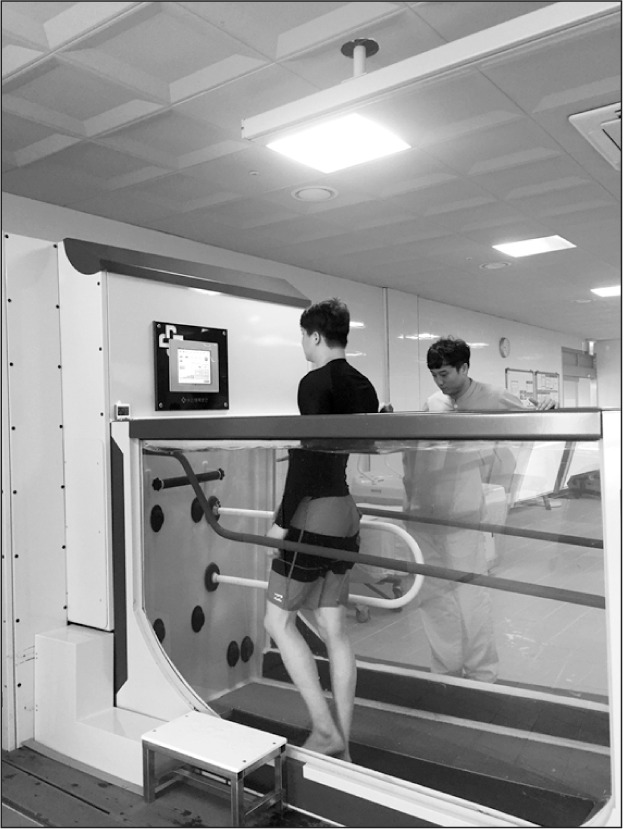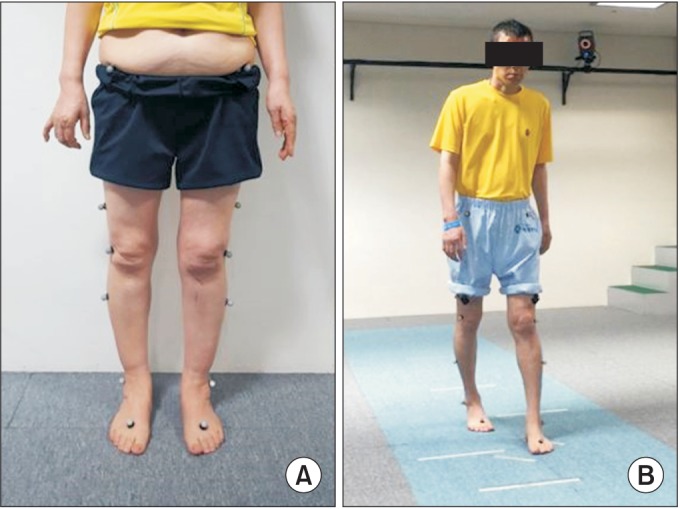Ann Rehabil Med.
2017 Jun;41(3):376-386. 10.5535/arm.2017.41.3.376.
Efficacy of Aquatic Treadmill Training on Gait Symmetry and Balance in Subacute Stroke Patients
- Affiliations
-
- 1Department of Physical Medicine and Rehabilitation, Inje University Haeundae Paik Hospital, Inje University College of Medicine, Busan, Korea. cyctaz@hanmail.com
- KMID: 2389452
- DOI: http://doi.org/10.5535/arm.2017.41.3.376
Abstract
OBJECTIVE
To determine the efficacy of aquatic treadmill training (ATT) as a new modality for stroke rehabilitation, by assessing changes in gait symmetry, balance function, and subjective balance confidence for the paretic and non-paretic leg in stroke patients.
METHODS
Twenty-one subacute stroke patients participated in 15 intervention sessions of aquatic treadmill training. The Comfortable 10-Meter Walk Test (CWT), spatiotemporal gait parameters, Berg Balance Scale (BBS), and Activities-specific Balance Confidence scale (ABC) were assessed pre- and post-interventions.
RESULTS
From pre- to post-intervention, statistically significant improvements were observed in the CWT (0.471±0.21 to 0.558±0.23, p<0.001), BBS (39.66±8.63 to 43.80±5.21, p<0.001), and ABC (38.39±13.46 to 46.93±12.32, p<0.001). The step-length symmetry (1.017±0.25 to 0.990±0.19, p=0.720) and overall temporal symmetry (1.404±0.36 to 1.314±0.34, p=0.218) showed improvement without statistical significance.
CONCLUSION
ATT improves the functional aspects of gait, including CWT, BBS and ABC, and spatiotemporal gait symmetry, though without statistical significance. Further studies are required to examine and compare the potential benefits of ATT as a new modality for stroke therapy, with other modalities.
Keyword
Figure
Reference
-
1. Grysiewicz RA, Thomas K, Pandey DK. Epidemiology of ischemic and hemorrhagic stroke: incidence, prevalence, mortality, and risk factors. Neurol Clin. 2008; 26:871–895. PMID: 19026895.
Article2. O'Sullivan SB, Schmitz TJ, Fulk GD. Physical rehabilitation. 6th ed. Philadelphia: F. A. Davis Company;2007. p. 385.3. Wall JC, Turnbull GI. Gait asymmetries in residual hemiplegia. Arch Phys Med Rehabil. 1986; 67:550–553. PMID: 3741082.4. Combs SA, Dugan EL, Passmore M, Riesner C, Whipker D, Yingling E, et al. Balance, balance confidence, and health-related quality of life in persons with chronic stroke after body weight-supported treadmill training. Arch Phys Med Rehabil. 2010; 91:1914–1919. PMID: 21112434.
Article5. Combs SA, Dugan EL, Ozimek EN, Curtis AB. Bilateral coordination and gait symmetry after body-weight supported treadmill training for persons with chronic stroke. Clin Biomech (Bristol, Avon). 2013; 28:448–453.
Article6. Becker BE. Aquatic therapy: scientific foundations and clinical rehabilitation applications. PM R. 2009; 1:859–872. PMID: 19769921.
Article7. Chu KS, Eng JJ, Dawson AS, Harris JE, Ozkaplan A, Gylfadottir S. Water-based exercise for cardiovascular fitness in people with chronic stroke: a randomized controlled trial. Arch Phys Med Rehabil. 2004; 85:870–874. PMID: 15179638.8. Yoo J, Lim KB, Lee HJ, Kwon YG. Cardiovascular response during submaximal underwater treadmill exercise in stroke patients. Ann Rehabil Med. 2014; 38:628–636. PMID: 25379492.
Article9. Jung T, Lee D, Charalambous C, Vrongistinos K. The influence of applying additional weight to the affected leg on gait patterns during aquatic treadmill walking in people poststroke. Arch Phys Med Rehabil. 2010; 91:129–136. PMID: 20103407.
Article10. Berg K, Wood-Dauphine S, Williams J, Gayton D. Measuring balance in the elderly: preliminary development of an instrument. Physiother Can. 1989; 41:304–311.
Article11. Botner EM, Miller WC, Eng JJ. Measurement properties of the Activities-specific Balance Confidence Scale among individuals with stroke. Disabil Rehabil. 2005; 27:156–163. PMID: 15824045.
Article12. Flansbjer UB, Holmback AM, Downham D, Patten C, Lexell J. Reliability of gait performance tests in men and women with hemiparesis after stroke. J Rehabil Med. 2005; 37:75–82. PMID: 15788341.13. Patterson KK, Parafianowicz I, Danells CJ, Closson V, Verrier MC, Staines WR, et al. Gait asymmetry in community-ambulating stroke survivors. Arch Phys Med Rehabil. 2008; 89:304–310. PMID: 18226655.
Article14. Patterson KK, Gage WH, Brooks D, Black SE, McIlroy WE. Evaluation of gait symmetry after stroke: a comparison of current methods and recommendations for standardization. Gait Posture. 2010; 31:241–246. PMID: 19932621.
Article15. Stevenson TJ. Detecting change in patients with stroke using the Berg Balance Scale. Aust J Physiother. 2001; 47:29–38. PMID: 11552860.
Article16. Blum L, Korner-Bitensky N. Usefulness of the Berg Balance Scale in stroke rehabilitation: a systematic review. Phys Ther. 2008; 88:559–566. PMID: 18292215.
Article17. Lewek MD, Randall EP. Reliability of spatiotemporal asymmetry during overground walking for individuals following chronic stroke. J Neurol Phys Ther. 2011; 35:116–121. PMID: 21934372.
Article18. Patterson KK, Mansfield A, Biasin L, Brunton K, Inness EL, McIlroy WE. Longitudinal changes in poststroke spatiotemporal gait asymmetry over inpatient rehabilitation. Neurorehabil Neural Repair. 2015; 29:153–162. PMID: 24826888.
Article19. Bressel E, Smith G, Miller A, Dolny D. Aquatic-treadmill walking: quantifying drag force and energy expenditure. J Sport Rehabil. 2012; pii: 2011-0096.
Article20. Bressel E, Wing JE, Miller AI, Dolny DG. High-intensity interval training on an aquatic treadmill in adults with osteoarthritis: effect on pain, balance, function, and mobility. J Strength Cond Res. 2014; 28:2088–2096. PMID: 25057845.21. Roper JA, Bressel E, Tillman MD. Acute aquatic treadmill exercise improves gait and pain in people with knee osteoarthritis. Arch Phys Med Rehabil. 2013; 94:419–425. PMID: 23131526.
Article22. Lambert BS, Greene NP, Carradine AT, Joubert DP, Fluckey JD, Riechman SE, et al. Aquatic treadmill training reduces blood pressure reactivity to physical stress. Med Sci Sports Exerc. 2014; 46:809–816. PMID: 24056269.
Article23. Jung T, Ozaki Y, Lai B, Vrongistinos K. Comparison of energy expenditure between aquatic and overground treadmill walking in people post-stroke. Physiother Res Int. 2014; 19:55–64. PMID: 23996962.
Article24. Park SW, Lee KJ, Shin DC, Shin SH, Lee MM, Song CH. The effect of underwater gait training on balance ability of stroke patients. J Phys Ther Sci. 2014; 26:899–903. PMID: 25013292.25. Balasubramanian CK, Bowden MG, Neptune RR, Kautz SA. Relationship between step length asymmetry and walking performance in subjects with chronic hemiparesis. Arch Phys Med Rehabil. 2007; 88:43–49. PMID: 17207674.
Article26. Anderson FC, Goldberg SR, Pandy MG, Delp SL. Contributions of muscle forces and toe-off kinematics to peak knee flexion during the swing phase of normal gait: an induced position analysis. J Biomech. 2004; 37:731–737. PMID: 15047002.
Article27. Goldberg SR, Anderson FC, Pandy MG, Delp SL. Muscles that influence knee flexion velocity in double support: implications for stiff-knee gait. J Biomech. 2004; 37:1189–1196. PMID: 15212924.
Article28. Bates A, Hanson N. Aquatic exercise therapy. Philadelphia: Saunders;1996.29. Hall J, Macdonald IA, Maddison PJ, O'Hare JP. Cardiorespiratory responses to underwater treadmill walking in healthy females. Eur J Appl Physiol Occup Physiol. 1998; 77:278–284. PMID: 9535590.
Article30. Matsumoto I, Araki H, Tsuda K, Odajima H, Nishima S, Higaki Y, et al. Effects of swimming training on aerobic capacity and exercise induced bronchoconstriction in children with bronchial asthma. Thorax. 1999; 54:196–201. PMID: 10325893.
Article31. Stevens SL, Caputo JL, Fuller DK, Morgan DW. Effects of underwater treadmill training on leg strength, balance, and walking performance in adults with incomplete spinal cord injury. J Spinal Cord Med. 2015; 38:91–101. PMID: 24969269.
Article
- Full Text Links
- Actions
-
Cited
- CITED
-
- Close
- Share
- Similar articles
-
- The Effects of Additional Balance Training in Subacute Hemiplegic Stroke Patients
- Comparison of Aquatic Treadmill and Anti-Gravity Treadmill Gait Training to Improve Balance and Gait Abilities in Stroke Patients
- Effects of Treadmill Gait Training According to Different Inclination on Postural Balance in Patients with Chronic Stroke
- Effects of Aquatic Proprioceptive Neuromuscular Facilitation Pattern Exercise on Balance, Gait ability and Depression in Patients with Chronic Stroke
- Effects of Knowledge of Result Versus Knowledge of Performance on Treadmill Training on gait ability in Stroke Patients: A Randomized Clinical Trial



